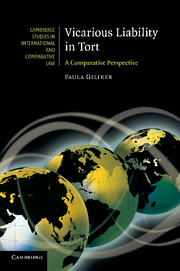Book contents
- Frontmatter
- Contents
- Diagrams
- Table of cases
- Table of legislation
- Preface
- 1 What is vicarious liability?
- 2 Establishing a general framework for liability
- 3 The employer/employee relationship: identifying the contract of employment
- 4 Special difficulties: borrowed employees and temporary workers
- 5 Other relationships giving rise to liability
- 6 Acting in the course of one's employment/functions/assigned tasks: determining the scope of vicarious liability
- 7 Parental liability for the torts of their children: a new form of vicarious liability?
- 8 Understanding vicarious liability: reconciling policy and principle
- 9 A postscript: a harmonised European law of vicarious liability?
- Appendix: Key provisions of the French and German Civil Codes
- Index
- Titles in the series
1 - What is vicarious liability?
Published online by Cambridge University Press: 10 November 2010
- Frontmatter
- Contents
- Diagrams
- Table of cases
- Table of legislation
- Preface
- 1 What is vicarious liability?
- 2 Establishing a general framework for liability
- 3 The employer/employee relationship: identifying the contract of employment
- 4 Special difficulties: borrowed employees and temporary workers
- 5 Other relationships giving rise to liability
- 6 Acting in the course of one's employment/functions/assigned tasks: determining the scope of vicarious liability
- 7 Parental liability for the torts of their children: a new form of vicarious liability?
- 8 Understanding vicarious liability: reconciling policy and principle
- 9 A postscript: a harmonised European law of vicarious liability?
- Appendix: Key provisions of the French and German Civil Codes
- Index
- Titles in the series
Summary
Introduction
The doctrine of vicarious liability lies at the heart of all common law systems of tort law. It represents not a tort, but a rule of responsibility which renders the defendant liable for the torts committed by another. The classic example is that of employer and employee: the employer is rendered strictly liable for the torts of his employees, provided that they are committed in the course of the tortfeasor's employment. In such circumstances, liability is imposed on the employer, not because of his own wrongful act, but due to his relationship with the tortfeasor. The claimant is thus presented with two potential defendants: the individual tortfeasor and a third party, likely to be with means and/or insured and usually clearly identifiable in circumstances where it may be difficult to identify the actual culprit in question. Any study of vicarious liability cannot therefore avoid consideration of its role in determining who ultimately bears the burden of paying compensation.
Nevertheless, it is a principle at odds with tort's traditional focus on general principles of individual responsibility. Traditionally described as ‘the law of civil wrongs’, a basic formulation of tort law may be summed up as rendering the tortfeasor liable for committing a wrong which has caused harm to another. A more sophisticated analysis may be stated in terms of corrective justice: ‘Corrective justice is the idea that liability rectifies the injustice inflicted by one person on another.’ Vicarious liability breaks this causal link.
- Type
- Chapter
- Information
- Vicarious Liability in TortA Comparative Perspective, pp. 1 - 20Publisher: Cambridge University PressPrint publication year: 2010
- 1
- Cited by



